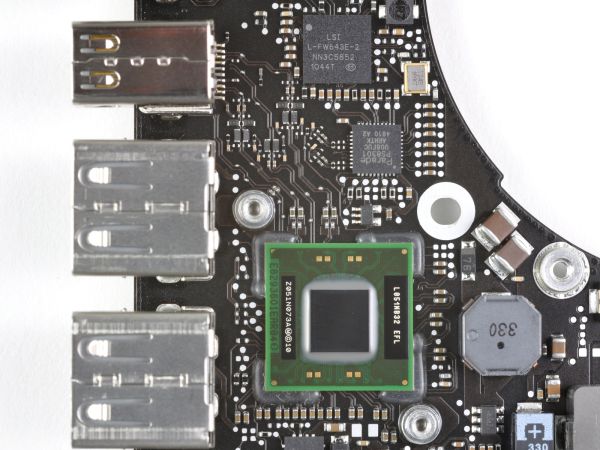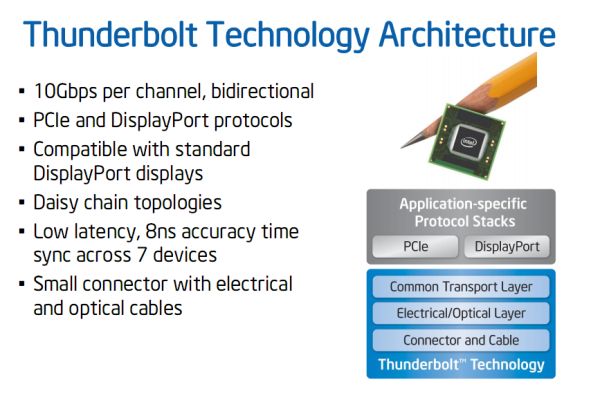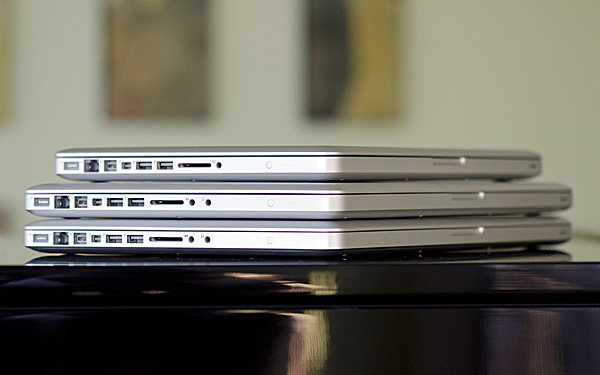Promise Pegasus R6 & Mac Thunderbolt Review
by Anand Lal Shimpi on July 8, 2011 2:01 AM ESTOne by one the barriers to mobile computing have been falling. In the early days you could move to a notebook but you'd give up a lot of CPU, GPU and I/O performance. SSDs really fixed the storage performance issue (2.5" hard drives are horrendously slow compared to their 3.5" counterparts), power gating and turbo boost helped address the CPU problem and I wouldn't be too surprised to see companies have another go at external GPU solutions for those who need the added graphics horsepower.
The idea of external GPUs brings up the current limitation we face in this mobile transition. Although being more mobile is great, we still want the best of both worlds: great performance when we're at a desk, and great battery life when mobile. Enabling the former is going to require new technologies as well as new high speed interfaces.
Intel has been at the forefront of many of the successful high bandwidth interfaces in the evolution of the PC industry. Will Thunderbolt be another feather in its cap? In February we got the first Thunderbolt enabled MacBook Pros and just last week Promise shipped the first Thunderbolt enabled storage device. It's time to put the two together.
Thunderbolt Recap
At the beginning of this year Intel, alongside Apple, finally introduced a productized version of the interface we'd previously only known as Light Peak. Given that the first instantiation of this interface used traditional copper wires and not an optical interface, Apple and Intel branded it Thunderbolt.

Thunderbolt Controller IC on 15" 2011 MacBook Pro - Courtesy iFixit
The interface is royalty free, although Intel is the only company that makes Thunderbolt controller needed to support the interface. There's no word on the cost of the Thunderbolt controller. Thunderbolt isn't an Apple exclusive, however we won't see PCs ship with the high bandwidth copper interface until 2012 at the earliest.
Thunderbolt is a high speed, dual-channel serial interface. Each channel is good for up to 10Gbps of bi-directional bandwidth (20Gbps total) and with two channels a single Thunderbolt link is enough for 40Gbps of aggregate bandwidth.

Thunderbolt can carry both PCIe and DisplayPort signaling. Apple claims that one of the channels is used for DisplayPort while the other is used for PCIe. DisplayPort interface support extends to the connector, which is physically compatible with a standard mini-DisplayPort connector. DisplayPort support is key as it allows video to be carried in addition to data, potentially allowing for some interesting use as a single cable docking solution for notebooks.
In addition to carrying up to 40Gbps of total bandwidth, a single Thunderbolt cable can also deliver up to 10W of power to connected devices.

Each Thunderbolt port can drive up to 7 daisy chained devices, although all devices must share the 40Gbps (up/down) bandwidth to the host.
There's an obvious comparison to USB 3.0 which currently tops out at 5Gbps, however even it offers only 1/4 of the total available bandwidth of the Thunderbolt PCIe channel (not to mention its inability to carry DisplayPort).











88 Comments
View All Comments
enthios - Thursday, July 28, 2011 - link
"Ironically isolated from the world around them?" How about wifi and iCloud? With limited storage capacity, there's no need for anything more. iOS devices are simply thin clients - and they work wonderfully as such.NirXY - Friday, July 8, 2011 - link
Which is 0$Exelius - Friday, July 8, 2011 - link
Yes, but in this instance, it's not just a dumb wire; there is an IC at each end of the cable. So theoretically, if Intel comes up with an upgraded Light Peak spec, there may well be cables that are capable of faster speeds. I also imagine longer cables become more difficult, and may in fact require fiber optic transceivers built into the cable. This cable also likely costs significantly more to manufacture than a crimped cable, since there's a tiny IC and micro soldering that needs to be done on each cable.But yes, in one sense you are right that in a digital bus, higher quality cables do not provide better performance (though I have run into very low-quality HDMI cables that work fine at 720p but refuse to carry a 1080p signal.)
repoman27 - Sunday, July 10, 2011 - link
At the moment, i’m not sure the Thunderbolt host controller has any real legs on the cable. That host controller is already pumping data to each port at the same speeds as the DMI link between the CPU and PCH. Everything in the chain that is connected to it needs to get faster for Thunderbolt to get faster, i.e. PCIe 3.0, DMI 3.0, DP 1.2.Also, I’m pretty sure it’s not those little ICs that are making Apple’s Thunderbolt cables cost $49. Like many retailers, Apple knows that cables and accessories (and RAM upgrades) are a great place to stretch profit margins. A quick search of the Apple store for cables and adapters will turn up dozens of genuine Apple offerings ranging in price from $19 on up to $99. So, taken in context, the Thunderbolt cable is actually a mid-priced cable from Apple, not an expensive one. It also means that cheap unbranded alternatives could quite realistically be sold for around $15, ICs and all.
Regarding your HDMI cable experience, Category 1 or “Standard” HDMI cables are only rated for 1080i60, whereas Category 2 or “High Speed” cables will do 1080p60, 4K, 3D, Deep Color, etc. Older cables weren’t marked as such, and thus YMMV.
snakeInTheGrass - Friday, July 15, 2011 - link
Yeah, the SCSI cables were $75+ easily, you needed terminators, and do you remember the fine SCSI1/2/3 connector differences so you needed adapters or cables with different ends depending on the devices. I still have probably what WAS $500 of cables in my closed.Inflation adjusted, these $50 cables are about the equivalent of $15 cables back in those days, so frankly they don't sound too bad, especially considering the fact that it's industry leading performance right now.
As for comparing to Monster cables, these Thunderbolt cables have controllers built into them and presumably do have to meet tighter tolerances than USB, particularly as they carry 2 x 10Gbps data streams. But you're right that Monster cables are a rip off.
flowynn - Friday, July 8, 2011 - link
I remember those days well. My need for speed SCSI habit was insanely expensive.MonkeyPaw - Friday, July 8, 2011 - link
It reminds me of FB-DIMMs, an expensive solution that uses additional energy, and the components cost more than devices it replaces. Controllers in the cables AND on the motherboard and peripherals? Maybe the optical solution will make more sense.CrimsonFury - Monday, July 11, 2011 - link
I thought the initial copper cables didn't need any controllers in them? The impression I got from earlier articles was that Intel said their Thunderbolt implementation could scale to optical in future for greater speeds by releasing optical cables with a copper to optical controller in each end of the cable once controller costs had come down from mass production.MobiusStrip - Tuesday, July 12, 2011 - link
No, they need optical in the ports and wires.By reneging on the light in "Light Peak", Intel effectively killed it. Who knows why they're playing dumb in pretending that they're going to get the industry to adopt Thunderbolt and then turn around and adopt an optical solution right afterward. Just idiotic.
André - Friday, July 8, 2011 - link
I find it especially funny considering that all current Thunderbolt solutions (A/V equipment or storage enclosures) are all in excess of $999 to begin with.